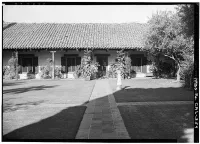Share what you know,
and discover more.
Share what you know,
and discover more.

-

- Marley Zielike
Rancho La Brea Adobe, 6301 West Third St Los Angeles, Los Angeles County, CA
"...the explorers saw some large marshes of a certain substance like pitch; they were boiling and bubbling, and the pitch came out mixed with an abundance of water. They noticed that the water runs to one side and the pitch to the other, and that there is such an abundance of it that it would serve to caulk many ships." The Indians used the brea, in fact, for just such a purpose. The plank canoes with which they navigated between the mainland and the Channel Islands were made water-tight with it. They also employed it to fix shell decorations in place, to secure fibre lashings, and as a fuel. A contingent of Spanish soldiers sent from San Diego in 1770, subsequent to Crespi`s report, found themselves forced to battle with the Indians encamped at the pits before they could return with the load of brea they had been ordered to fetch.
Rancho La Brea Adobe, 6301 West Third St Los Angeles, Los Angeles County, CA
"...the explorers saw some large marshes of a certain substance like pitch; they were boiling and bubbling, and the pitch came out mixed with an abundance of water. They noticed that the water runs to one side and the pitch to the other, and that there is such an abundance of it that it would serve to caulk many ships." The Indians used the brea, in fact, for just such a purpose. The plank canoes with which they navigated between the mainland and the Channel Islands were made water-tight with it. They also employed it to fix shell decorations in place, to secure fibre lashings, and as a fuel. A contingent of Spanish soldiers sent from San Diego in 1770, subsequent to Crespi`s report, found themselves forced to battle with the Indians encamped at the pits before they could return with the load of brea they had been ordered to fetch.
Rancho La Brea Adobe, 6301 West Third St Los Angeles, Los Angeles County, CA
"...the explorers saw some large marshes of a certain substance like pitch; they were boiling and bubbling, and the pitch came out mixed with an abundance of water. They noticed that the water runs to one side and the pitch to the other, and that there is such an abundance of it that it would serve to caulk many ships." The Indians used the brea, in fact, for just such a purpose. The plank canoes with which they navigated between the mainland and the Channel Islands were made water-tight with it. They also employed it to fix shell decorations in place, to secure fibre lashings, and as a fuel. A contingent of Spanish soldiers sent from San Diego in 1770, subsequent to Crespi`s report, found themselves forced to battle with the Indians encamped at the pits before they could return with the load of brea they had been ordered to fetch.Posted Date
Sep 27, 2021
Source Name
Library of Congress
Source Website
Delete Story
Are you sure you want to delete this story?










